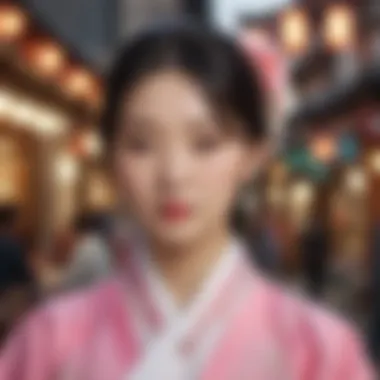The Significance of 'Everyone is There' in Korean Drama


Intro
The phrase “Everyone is there” holds profound significance within Korean drama. This article investigates how this concept sustains a narrative connection among characters and fosters a strong sense of community in the storyline. It plays a crucial role in illustrating cultural values as seen in modern South Korean society. Through various dramatic techniques and character arcs, writers create rich, intricate worlds that resonate deeply with audiences.
Korean dramas frequently explore themes related to family, friendship, and love, allowing the audience to identify with various characters while emphasizing the human experience shared throughout the series. This exploration offers an insight into contemporary issues relevant to people of all ages, reflecting society's evolving norms and traditions.
By engaging with culturally familiar elements, creators can allow viewers to feel connected not only to their favorite characters but also to the broader landscape of shared human experiences. Taiwanese beauty standards depicted in popular shows illustrate how these stories transcend cultural boundaries — uniting individuals across their differences.
Trend Report
In the context of Korean dramas, certain trends punctuate the narrative style and thematic exploration of “everyone is there.” By understanding these trends, we can delve deeper into the essence of what makes Korean drama unique.
- Community Dynamics: Recent dramas emphasize interconnected stories, showcasing how individuals’ paths converge in unexpected ways.
- Character Depth: Writers are adopting more nuanced characters, which focus on the holistic portrayal of conflicting emotions and ambitions.
- Cultural Representation: Global audiences witness the growing portrayal of diverse narratives that enhance the relatable nature of Korean dramas.
These trends point toward a broader cultural inclination carbonated by global appeal facilitated by various streaming platforms.
Character Development Plays
The successful portrayal of
Preface to Korean Drama
Korean dramas have gained significant popularity on a global scale. Their ability to resonate with audiences across cultures stems in part from the richness of their storytelling. The themes within these dramas often reflect societal values, cultural heritage, and human emotions. One such recurring phrase in this context is 'Everyone is there.' This phrase encapsulates the essence of community, highlighting the connections between characters and the shared experiences that foster a deeper emotional resonance.
It is important to understand the historical context and cultural impact that shape Korean dramas. Analyzing these aspects can illuminate the narrative decisions that writers make, especially regarding character development and the construction of emotional arcs. This analysis sets the groundwork for deeper appreciation of the significance of the phrase within the Korean cultural landscape.
Historical Context
The rise of Korean drama can be traced back to the late 20th century, specifically in the 1990s. Television dramas started to emerge as a popular medium, reflecting societal changes and the advent of new technology. During this time, South Korea experienced rapid modernization, giving birth to stories that both mirrored and challenged traditional values.
The phrase 'Everyone is there' is often illustrated through ensemble casts in these early dramas. Whether set in a family or a community, these stories emphasized a unity that resonated with viewers who experienced the same societal transitions on personal levels. Each character often portrayed relatable traits, further enhancing the audience's connection to their journeys.
Also, historical milestones, such as the Asian Financial Crisis in the late '90s, pushed families closer together and created a shared sense of vulnerability. The dramas of this era often provided an escape, one where characters faced adversity together. Thus, understanding this backdrop offers valuable insight into why community-based values are both common and significant in current storytelling.
Cultural Impact
The cultural impact of Korean dramas extends beyond entertainment; they serve as social mirrors, reflecting the norms and values of society. By presenting themes like family unity, friendship, and community, Korean dramas nurture a collective identity. The importance of social connections—exemplified by the phrase 'Everyone is there'—captures the audience's attention and emphasizes what it means to belong.
Recent success on platforms such as Netflix has allowed Korean dramas to penetrate the global market, paving the way for cultural exchanges. The widespread interest in these dramas speaks volumes about their ability to synthesize universal themes and Korean cultural elements. Global audiences appreciate the communal values embedded in these narratives, highlighting principles of empathy and shared human experience.
Furthermore, the rise of fan cultures surrounding specific dramas illustrates the power of community not just in stories, but in real-life interactions among viewers. This shared appreciation fosters a sense of belonging, reinforcing the reverberating significance of 'Everyone is there' as a thematic element in Korean storytelling.
Understanding the Phrase 'Everyone is There'


The phrase 'Everyone is there' serves as a fundamental element within the Korean drama landscape. This concept resonates deeply with both creators and viewers, forming a concentrated narrative strain in the fabric of these stories. It addresses not only the plots that habit in fictional worlds but also the social commentaries threaded throughout these series. A deeper understanding of this phrase reveals its importance in building character relationships and establishing communal identities.
Definition and Interpretation
To grasp the implications of 'Everyone is there,' one must first define what this phrase encapsulates in the realm of Korean drama. Primarily, it symbolizes inclusivity and togetherness in various forms. It encompasses families, friendships, and romantic bonds. The characters often reflect on shared experiences, underlining that their individual struggles and triumphs resonate collectively. This sense of unity fosters a narrative environment where audiences can see parts of themselves reflected in these relationships.
Moreover, characters positioned in engaging dynamics communicate messages that speak to societal conditions. A group of friends gathering for a meal or supporting each other during challenging life moments serves not just as plot points but rather as reflections of real-world connections and community engagement.
Relevance in Contemporary Society
In the context of contemporary society, the relevance of 'Everyone is there' is unmistakably pronounced. Today's world is marked by increased social fragmentation, with digital interactions often replacing physical connections. In this scenario, Korean dramas become a refuge, representing ideals of togetherness. They provide a sense of belonging for viewers who may feel isolated in their daily lives.
Korean dramas encourage viewers to reflect on forms of support they can give and receive. The core theme emphasizes how relationships shape individual experiences, mirroring the importance of community in overcoming personal challenges. Additionally, it ignites discussions around the various dimensions of community, helping to bridge divides in a polarized world.
“Everyone is there highlights not just fictional stories but urges discussions on the genuine significance of community, friendship, and support.”
The generational gap also contributes to the theme's appeal. Younger generations especially can relate to the subtleties, making them more likely to engage with these narratives. This connection rests on an emotional investment that evolves together with the viewer's experiences and societal interactions. Hence, the phrase transcends the screen, instilling a greater understanding of the value of presence—in stories and life.
Narrative Functions of 'Everyone is There'
The phrase 'Everyone is there' serves as a crucial touchstone in Korean drama narratives. It encapsulates the essence of diverse character interactions and the interconnectedness that defines Korean storytelling. Finding significance in this theme not only enriches plot development but also heightens viewers' emotional stakes, making it a pivotal element in the overall drama experience.
Character Development
In Korean dramas, character development often hinges on the presence of supportive relationships. When we see characters relying on friends, family, or even coworkers, it amplifies their growth arcs. For instance, in Reply 1988, the interplay between the main characters and their community shapes their individual journeys. The narrative proficiency lies in demonstrating how these relationships create a backdrop for personal evolution. Watching characters define themselves alongside others also presents conflicting traits and secrets. As these hidden layers unfold among different relationship dynamics, they make each character asymmetric, which leads to more believable storytelling.
Additionally, character decisions in these dramas are rarely isolated. They resonate with others, often prompting reactions and influencing outcomes. This intertwined development allows viewers to engage more deeply, witnessesing transformations that may not occur in isolation. In many instances, seemingly minor characters offer essential points of view, emphasizing how every individual contributes uniquely toward collective growth.
Conflict Resolution
Conflict within Korean drama is rife, yet it frequently finds resolution through the shared bonds cultivated amongst characters. The idea of everyone standing similar provides a foundation for navigating tensions. In My Love From the Star, when conflicts arise, they often are not resolved through confrontation but instead through collective understanding. By showing mutual support and open dialogue, relationships move beyond superficial animosities, allowing true harmony to substitute discord.
Moreover, when a character feels isolated, the lack of support amplifies their internal conflict, mirroring real-life struggles. This connectivity becomes essential in resolving both sentimental and practical disagreements through reliance on the values of community. A moment of understanding or forgiveness reveals the beauty in simplicity, illustrating that teamwork carries its charm in any group dynamic.
Characters are often redeemed through their collaboration. They gain resolution and closure which not only satisfies viewers but affirm the notion that humanity thrives through connection and support.
Emotional Engagement
Emotional engagement thrives in the richness of community relationships within Korean dramas. The moment when everyone is there is not just a setting; it's a snapshot of shared experience and collective emotion. Viewers often resonate with the emotional arcs of characters, and once invested, every conflict or achievement carries weight.
Take Hospital Playlist as an example—essentially a drama that relies on a friend-group dynamic filled with laughter and sorrow. The shared moments create memorable emotional resonance and draw the audience into a narrative vortex. It amplifies incidents, where joy multiplies in the company of others, and losses sting more, expressing intricacies of human bonding.
Impact on Viewers
Korean dramas have a profound influence on their audience. The phrase "Everyone is there" reveals a deeper connection viewers create with the narrative. This sense of togetherness resonates strongly with individuals who often seek this feeling in the fast-paced complexities of modern life. As audiences consume these shows, they engage with the idea that relationships are central to understanding the human experience.


One significant aspect of this shared experience is community building. Viewers often form online and offline communities. These connections arise from a mutual love for the same dramas, characters, and stories. When viewers discuss episodes or characters on platforms like reddit.com or social media, they carve out an environment where everyone can belong. This not only strengthens individual relationships but fosters new ones, creating a sense of kinship that transcends geographic boundaries.
Another notable psychological impact concerns emotional feedback loops. The interaction between fans can deepen their connection to the narratives presented on screen. Conversations about compelling moments often cultivate excitement. That enthusiasm can generate a compounding cyclical effect for the dramas themselves. As viewers rally around their shared experiences, it ignites conversations that attract more people to the shows, ricocheting the emotional engagement.
Additionally, broadcasting the phrase "Everyone is there" underscores an essential lesson: valuing connection. Within its context, certainly extends externally, impacting individuals’ lives. Indeed, this prioritization of togetherness encourages viewers to appreciate relationships in their lives, promoting empathy and reflection.
The sense of community formed through the consuming experience is more impactful than just entertainment; it's a way for catastrophic bonds to be formed.
In sum, the impact of Korean dramas on viewers captivates them through engaging narratives and emotional communal experiences. The phrase encourages unity amidst the challenges Dictate are often associated with life. This synergy binds audiences together an reminding them they are not alone in their experiences or feelings.
Community Building among Fans
The presence of interactivity among fans emerges as a vital extension of the drama spectacle. As viewers rally around characters, most notably around the theme "Everyone is there", they build a sense of belonging. Forums like facebook.com and discussion sites propel the spirit of fan contribution foward. This social engagement allows people to traverse geographical impossibilities in search of solidarity and perspective.
As fans share opinions and analysis about the plot lines, the community often creates definitions and interpretations of their shared understanding post drama consumption. Fans even engage in doing reviews that often become benchmarks influencing new viewers.
Rallies around certain themes create a residency to jot similar emotion deadened when assosiated with storytelling rebounds around shared and profound occasions. In this manner, each participating individual becomes instrumental in cultivating the camaraderie one feels by having shared feelings and opinions surrounding the show. This expands how viewers want contribute passionately back towards dynamics driving the stories in fan driven societies.
Cultural Exchange and Global Reach
Korean dramas extend beyond just a domestic audience, demonstrating a global appeal marked by cultural exchangesd. As broadcasts travel worldwide they set the stage for multicultural engagement. People from various regions express enthusiasm, prompting dialogues about their perspectives and communities inspired by aforementioned themes.
This exchange allows twofold impact ngen it features viewers open repeating_ex_perience similar self_and enhance variety within compleamentaries, converting observers ment into deeper reflections that gives way holding multi-personality aspects highlighting rich societal differences alive through narrative dramatizations specific occasions.
Through translation shared platforms, audiences worldwide can now feel as though they too shout together declaring proclaiming that everyone related Join parental moments they share visited commonalities beneath physical surface that encasing exterior unrelated solitary ideations fighting internal warning solely based. There feelings can entirely chang contemplations & expand diversity offer techniques for capture wide audiences still feeling always stable them tailored approach follows diversity complex gathered global at anyone corner needing present is at social barriers popular.
以上の課題を書いた後の考慮すべき点がすべて解説され - Show how humanity continuously resonates universality present reason enables actions that expand societal networks and explorations grow redemption cameras always shedding light redefining core aspects traditionalagrams toward hopeful unison hope.
Examples of Popular Dramas
The phrase 'Everyone is there' is not merely a tagline in Korean dramas but a critical narrative element that resonates deeply with the audience. Its significance can be illuminated through the analysis of several popular dramas that encapsulate this theme. By choosing shows that emphasize communal involvement and character cohesion, we can better appreciate this vital representation in contemporary society.
Dramas Featuring Strong Communities
Korean dramas often portray vibrant, interconnected communities where relationships drive the storyline. One notable example is Reply 1988, which focuses on a group of friends and their families living in a tight-knit neighborhood. This drama displays various aspects of life, showcasing how interconnected lives foster mutual reliance and emotional growth. Each character brings depth to the narrative, revealing how their individual experiences mesh into a larger community tapestry.
The impact of Hospital Playlist cannot be overlooked. This drama highlights the lives of medical students who have remained friends for over 20 years. Their enduring bond demonstrates not only friendship but the commitment to support each other in both personal and professional challenges. Here, the phrase 'Everyone is there' describes loyalty, solidarity, and an instantaneous network of support.
Other examples include Age of Youth and My Mister, where the theme emphasizes bonds among various characters across different generations. These shows essentially explore emotional connections in environments often challenged by hardship. Each narrative serves as a reminder of how community can act as a refuge and a space for emotional prosperity.
Analysis of Specific Episodes
Examining specific episodes within these dramas can deepen our understanding of how the 'Everyone is there' theme enhances storytelling. For instance, the episode in Reply 1988 where characters come together to celebrate memorable moments illustrates how collective experiences are a fundamental aspect of human existence. The sense of unity and shared joy evokes nostalgia and closeness among viewers.


In Hospital Playlist, the episode where the group reunites for a friend's birthday showcases the importance of continuity and commitment in friendships. The celebration, filled with laughter and special moments, encapsulates how the stakes of friendship shift more intricate issues—loss, joy, aspirations—and solidifies this theme profoundly.
As such, scenes like these leverage the , revealing both individual challenges and community influences. Importantly, these excerpts serve to demonstrate how narratives intertwine personal growth, communal support, and emotional interconnectedness.
The strength of community in Korean dramas emphasizes how vital relationships can shape individual narratives and enhance emotional engagement.
In summary, these examples encapsulate not only the heart of Korean drama but also the societal reflections they offer. Through understanding these story arcs and characters, viewers are invited to examine their perceptions of connection, community, and what it truly means for 'Everyone to be there'.
Critiques of the 'Everyone is There' Concept
The phrase 'Everyone is there' encapsulates a fundamental element of Korean dramas, but its implications deserve careful examination. As popular narratives often rely on this theme, certain critiques arise regarding the execution and overall impact it provides both on storytelling and audience perception. The arguments do not merely dismiss the concept; they aim to understand its relevance and identify the nuances that emerge from its repeated use.
Overuse and Cliché
One notable critique centers around the overuse of the 'Everyone is there' trope, resulting in a strong impression of cliché within contemporary storytelling. In many dramas, the repeated emphasis on community can lead to predictability in plot development. When conflicts or resolutions repeatedly involve the same cast of characters rallying together, the novelty of these dynamics may start to fade.
As audiences develop familiarity with these thematic routines, engagement might wane. Viewers may begin to recognize the pattern, which detracts from genuine emotional connections that dramas typically aim to evoke. In high-stakes narratives, reliance on characters' collective presence can simplify otherwise complex situations. From a critical perspective, it raises questions about originality and depth in character-driven narratives.
Factors Contributing to Cliché
- Stereotypical Character Types: Scripting often entails predictable roles such as the devoted friend or the sacrificial figure. These types risk flattening character development.
- Similar Plots Across Series: The execution can merge narratives making them feel repetitive, leading to viewer fatigue.
- Inconsistent Quality: The quality of storytelling suffers when the motif is handled without creativity, often relying on emotional shortcuts rather than authentic character journeys.
Balancing Reality and Fiction
Another significant aspect of critique involves the delicate interplay between reality and fiction. The idealized representation of community presence can lead to unrealistic portrayals of life. Korean dramas often glorify communal bonds, creating a warmth and connection that feels distant from viewers' daily experiences.
Brook performances portrayed in dramas leave audiences yearning for ideals of shared human experiences. However, the reality is that every relationship, whether familial or friendship, comes with complexity and divergence. In some cases, this idealization ignores crucial issues such as alienation, rivalry, or conflict-resolution. Such perspectives suggest that while the presentation of community is meaningful, it must correlate to authentic experiences to maintain interest and relevance.
Considerations for Authentic Portrayals
- Reflecting Divided Societies: Writers are urged to include themes of disconnection or disunity to mirror the reality faced by modern society, fostering a more balanced view.
- Character Flaws and Evolved Relationships: Portraying characters as multi-dimensional can enrich the narrative offering both warmth and complexity.
- Audience Acceptance of Flaws: Societal trends lead viewers to appreciate characters facing struggles rather than perpetually embodying ideals that do not accurately reflect life's realities.
A deeper understanding of 'Everyone is there' reveals that while it can be an essential driver of community, its critiques highlight the necessity of innovation in storytelling, emphasizing that a connection does not excuse stagnation or idealism.
Crafting resonant narratives in Korean dramas that embrace both community and individuality can offer an richer storytelling landscape. Эти аспекты—критика и поэтому баланс могут раскрыть более сложное гуманное воздействие на зрителей, что, в свою очередь, может выглядеть во многих сюжетах.
The End
The concept of 'Everyone is There' holds a pivotal position in understanding the thematic underpinnings of Korean dramas. This phrase encapsulates more than just a narrative choice; it signifies a profound connection that resonates deeply with the modern audience.
The Future of Korean Drama
As the landscape of Korean drama continues to evolve, the importance of 'Everyone is There' remains steadfast. Upcoming dramas are likely to explore this theme with greater complexity. Writers may delve into more nuanced portrayals of community, potentially reflecting changing social dynamics within South Korea and beyond.
Moreover, enhanced technological platforms contribute to a broader audience reach. Streaming services allow diverse stories to connect legends that might have otherwise gone unnoticed. This democratization of storytelling avails various perspectives, contributing to richer narratives around the concept of community, enhancing the impact of the phrase.
Final Thoughts on Community and Connection
Ultimately, the phrase 'Everyone is There' is not merely a hopeful sentiment. It solidifies the foundation of connection that viewers so deeply cherish. Through creating stereotypes or flipping narratives, Korean dramas draw one closer to the fabric of life. These moments foster discussion and camaraderie among viewers, often leading to online communities dedicated to exploring these shows further.
Korean dramas provide experimental stages for social values and collective cultural-oriented narratives, promising that this theme will endure as society navigates through times of rapid cultural exchange and connection. In this intricate relationship with the audience, 'Everyone is There' becomes more than a phrase; it's a vital social commentary in a gradually better-understood global community.



